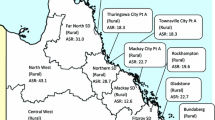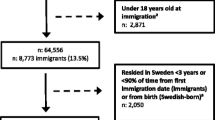Abstract
Background
There is little evidence on the association between suicide outcomes (ideation, attempts, self-harm) and social capital. This paper investigates such associations using a structural equation model based on health survey data, and allowing for both individual and contextual risk factors.
Methods
Social capital and other major risk factors for suicide, namely socioeconomic status and social isolation, are modelled as latent variables that are proxied (or measured) by observed indicators or question responses for survey subjects. These latent scales predict suicide risk in the structural component of the model. Also relevant to explaining suicide risk are contextual variables, such as area deprivation and region of residence, as well as the subject's demographic status. The analysis is based on the 2007 Adult Psychiatric Morbidity Survey and includes 7,403 English subjects. A Bayesian modelling strategy is used.
Results
Models with and without social capital as a predictor of suicide risk are applied. A benefit to statistical fit is demonstrated when social capital is added as a predictor. Social capital varies significantly by geographic context variables (neighbourhood deprivation, region), and this impacts on the direct effects of these contextual variables on suicide risk. In particular, area deprivation is not confirmed as a distinct significant influence. The model develops a suicidality risk score incorporating social capital, and the success of this risk score in predicting actual suicide events is demonstrated.
Conclusions
Social capital as reflected in neighbourhood perceptions is a significant factor affecting risks of different types of self-harm and may mediate the effects of other contextual variables such as area deprivation.





Similar content being viewed by others
References
Almedom A (2005) Social capital and mental health: an interdisciplinary review of primary evidence. Soc Sci Med 61:943–964
Beautrais A (2001) Suicides and serious suicide attempts: two populations or one?. Psychological Medicine 31:837–845
Borowsky I, Ireland M, Resnick M (2001) Adolescent suicide attempts: risks and protectors. Pediatrics 107:485–493
Botega N, Barros M, Oliveira H, Dalgalarrondo P, Marín-León L (2005) Suicidal behavior in the community: prevalence and factors associated with suicidal ideation. Rev Bras Psiquiatr 27:45–53
Bronisch T, Wittchen H (1994) Suicidal ideation and suicide attempts: comorbidity with depression, anxiety disorders, and substance abuse disorder. Eur Arch Psychiatry Clin Neurosci 244:93–98
Brooks S, Gelman A (1998) General methods for monitoring convergence of iterative simulations. J Comput Graph Stat 7:434–445
Cadwallader M (1987) Linear structural relationships with latent variables: the LISREL model. Prof Geogr 39:317–326
Cheng A, Chen T, Chen C, Jenkins R (2000) Psychosocial and psychiatric risk factors for suicide. Case–control psychological autopsy study. Br J Psychiatry 177:360–365
Chioqueta A, Stiles P, Tore C (2007) The relationship between psychological buffers, hopelessness, and suicidal ideation: identification of protective factors. J Crisis Interv Suicide Prev 28:67–73
De Silva M, McKenzie K, Harpham T, Huttly S (2005) Social capital and mental illness: a systematic review. J Epidemiol Community Health 59:619–627
Dutt K, Webber M (2009) Access to social capital and social support amongst South East Asian women with severe mental health problems: a cross-sectional survey. Int J Soc Psychiatry (epub ahead of print)
Eudy R (2006) Structural equation modeling: a solution for measurement issues in public health research and evaluation. Presented at measurement issues and analyses for public health research and evaluation, 134th Annual Meeting & Exposition, American Public Health Association, Boston
Evans J, Middleton N, Gunnell D (2004) Social fragmentation, severe mental illness and suicide. Soc Psychiatry Psychiatr Epidemiol 39:165–170
Fitzpatrick K, Irwin J, Lagory M, Ritchey F (2007) Just thinking about it: social capital and suicide ideation among homeless persons. J Health Psychol 12:750–760
Gelfand A, Smith A (1990) Sampling based approaches to calculate marginal densities. J Am Stat Assoc 85:398–409
Goldney R (2005) Suicide prevention: a pragmatic review of recent studies. Crisis 26:128–140
Helliwell J (2006) Well-being and social capital: does suicide pose a puzzle? Soc Indic Res 81:455–496
Ibrahim J, Chen MH, Sinha D (2001) Bayesian survival analysis. Springer, New York
Johnson J, Wood A, Gooding P, Taylor P, Tarrier N (2011) Resilience to suicidality: the buffering hypothesis. Clin Psychol Rev 31:563–591
Johnston A, Cooper J, Kapur N (2006) Exploring the relationship between area characteristics and self-harm: old and new approaches. Crisis 27:88–91
Kelly B, Davoren M, Mhaoláin A, Breen E, Casey P (2009) Social capital and suicide in 11 European countries: an ecological analysis. Soc Psychiatry Psychiatr Epidemiol 44:971–977
Kiely J (1991) Some conceptual problems in multivariable analyses of perinatal mortality. Paediatr Perinat Epidemiol 5:243–257
Kushner H, Sterk C (2005) The limits of social capital: Durkheim, suicide, and social cohesion. Am J Public Health 95:1139–1143
Lunn D, Spiegelhalter D, Thomas A, Best N (2009) The BUGS project: evolution, critique and future directions. Stat Med 28:3049–3067
McCulloch A (2001) Social environments and health: a cross sectional survey. Br Med J 323:208–209
McKenzie K (2000) Neighbourhood safety and mental health outcomes. http://www.worldbank.org/poverty/scapital/sctalk/talk28.htm
McLean J, Maxwell M, Platt S, Harris F (2008) Risk and protective factors for suicide and suicidal behaviour: a literature review. Scottish Government Social Research, Edinburgh
McManus S, Meltzer H, Brugha T, Bebbington P, Jenkins R (2009) Adult psychiatric morbidity in England, 2007: results of a household survey. NHS Information Centre, Leeds
Matlin S, Molock S, Tebes J (2011) Suicidality and depression among african american adolescents: the role of family and peer support and community connectedness. Am J Orthopsychiatry 81:108–117
Neeleman J (2002) Beyond risk theory; suicidal behaviour in its social and epidemiological context. Crisis 23:114–120
Nelson C, Johnston M, Shrivastava A (2010) Improving risk assessment with suicidal patients: a preliminary evaluation of the clinical utility of the Scale for Impact of Suicidality–Management, Assessment and Planning of Care (SIS–MAP). Crisis 31:231–237
Nicholson S, Jenkins R, Meltzer H (2009) Suicidal thoughts, suicide attempts and self-harm. In: McManus S, Meltzer H, Brugha T, Bebbington P, Jenkins R (eds) Adult psychiatric morbidity in England, 2007: results of a household survey, Chap 4 . NHS Information Centre, Leeds, pp 71–87
Nock M, Borges G, Bromet E (2008) Cross-national prevalence and risk factors for suicidal ideation, plans and attempts. Br J Psychiatry 192:98–105
Oakes J, Rossi P (2003) The measurement of SES in health research: current practice and steps toward a new approach. Social Sci Med 56:769–784
Pirkis J, Burgess P, Dunt D (2000) Suicidal ideation and suicide attempts among Australian adults. Crisis 21:16–25
Resnick M, Ireland M, Borowsky I (2004) Youth violence perpetration: what protects? What predicts? Findings from the National Longitudinal Study of Adolescent Health. J Adolescent Health 35:424.e1–424.e10
Rhodes A, Bethell J, Spence J, Links P, Streiner D, Jaakkimainen R (2008) Age–sex differences in medicinal self-poisonings: a population-based study of deliberate intent and medical severity. Soc Psychiatry Psychiatr Epidemiol 43:642–652
Sammel M, Ryan L, Legler J (1997) Latent variable models for mixed discrete and continuous outcomes. Journal of the J Roy Stat Soc B 59(3):667–678
Shishehbor M, Litaker D (2006) Socio-economic status and mortality. Ann Intern Med 144:781–782
Singh-Manoux A, Clarke P, Marmot M (2002) Multiple measures of socio-economic position and psychosocial health: proximal and distal measures. Int J Epidemiol 31:1192–1199
Spiegelhalter D, Best N, Carlin B, van der Linde A (2002) Bayesian measures of model complexity and fit. J Royal Stat Soc B 64:583–639
Stevenson H (1998) Raising safe villages: cultural ecological factors that influence the emotional adjustment of adolescents. J Black Psychol 24:44–59
Tarrier N, Barrowclough C, Andrews B, Gregg L (2004) Risk of non-fatal suicide ideation and behaviour in recent onset schizophrenia–the influence of clinical, social, self-esteem and demographic factors. Soc Psychiatry Psychiatr Epidemiol 39:927–937
Taylor R, Page A, Morrell S, Carter G, Harrison J (2004) Socio-economic differentials in mental disorders and suicide attempts in Australia. Br J Psychiatry 185:486–493
Trout D (1980) The role of social isolation in suicide. Suicide Life Threat Behav 10:10–23
Turner R, Marino F (1994) Social support and social structure: a descriptive epidemiology. J Health Soc Behav 35:193–212
Veenstra G, Luginaah I, Wakefield S, Birch S, Eyles J, Elliott S (2005) Who you know, where you live: social capital, neighbourhood and health. Soc Sci Med 60:2799–2818
Welch S (2001) A review of the literature on the epidemiology of parasuicide in the general population. Psychiatr Serv 52:368–375
Acknowledgments
The analysis in this paper is based on the 2007 Psychiatric Morbidity Survey data held at the ESRC Data Archive. Neither the survey depositors nor the Data Archive bear any responsibility for the analysis presented in the paper.
Author information
Authors and Affiliations
Corresponding author
Appendix 1: model specification
Appendix 1: model specification
Consider the model form without indexing by gender, for simplicity. Under model 1 the measurement model for the latent suicide risk scores S i is
where Bern(ρ) denotes a Bernoulli variable with probability ρ. The structural component in model 1 specifies dependence of the predicted risk S.P i on the latent scales {SES, ISOL} and on demographic and contextual variables:
where region effects are random, and τ 2REG is their variance. The measurement model for SES involves the continuous indicator income, and four binary indicators, so that
The measurement model for ISOL involves three binary indicators, so that
In model 2 the structural component is expanded to include the effect of social capital (SCAP):
SES and ISOL are measured as for model 1, while for SCAP there are P = 18 binary indicators. Hence
In model 3, a differential intercept and construct effects are included according to psychiatric illness present (D i = 2) or absent (D i = 1), with the structural model becoming
Because the latent scales {S, SES, ISOL, SCAP} have a preset variance of 1, the item loadings {κ 2k , λ 1r , δ r , λ 2q , λ 3p } in the above models are all unknowns. To ensure consistent construct labelling, the initial loadings for each construct are constrained to be positive via gamma priors: \(\kappa _{21}\sim Ga(1,1),\lambda _{11}\sim Ga(1,1),\lambda _{21}\sim Ga(1,1),\) and \(\lambda_{31}\sim Ga(1,1).\) Remaining loadings are assigned N(0,10) priors. N(0,100) priors are adopted for β coefficients in the structural model, for the δ coefficients in the SES measurement model, and for the intercepts {κ 1k , γ 1r , γ 2q , γ 3p }. The precisions 1/τ 2REG and 1/σ 21 are assigned Ga(1,0.001) priors.
Let x j generically denote one of the latent constructs SCAP, SES, or ISOL, or one of the observed predictors AGE, WHITE or ADEP. Then standardised coefficients (in Tables 4, 5) express change in suicidality S (in standard deviations) in response to a standard deviation change in x j :
Comparable standardised effects of region are obtained as
Rights and permissions
About this article
Cite this article
Congdon, P. Latent variable model for suicide risk in relation to social capital and socio-economic status. Soc Psychiatry Psychiatr Epidemiol 47, 1205–1219 (2012). https://doi.org/10.1007/s00127-011-0429-x
Received:
Accepted:
Published:
Issue Date:
DOI: https://doi.org/10.1007/s00127-011-0429-x




